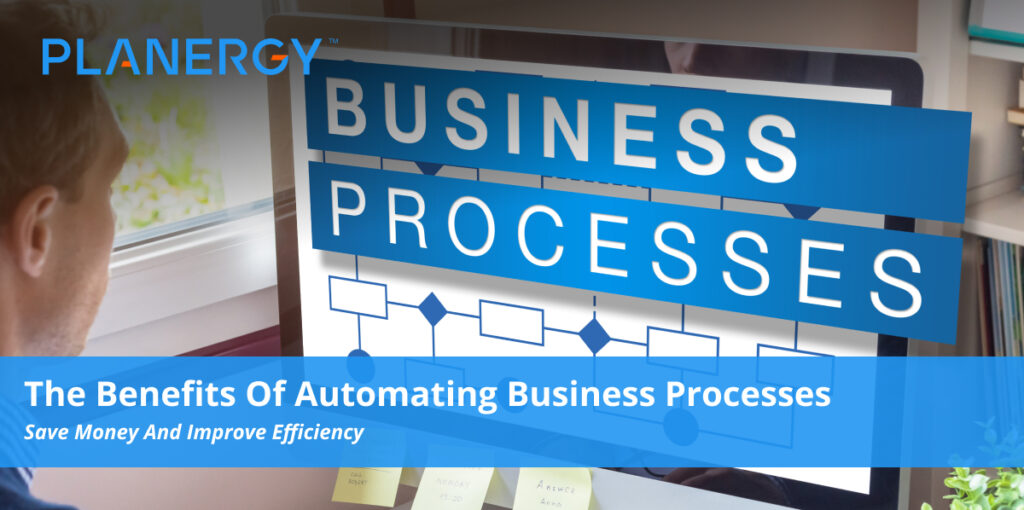In the quest to minimize costs while still getting the biggest possible return on investment (ROI), companies look for opportunities to cut spend wherever they can.
But in the age of digital transformation, creating value through strategic optimization—in particular, through the use of business process automation—is as crucial as finding immediate savings through lower costs.
Automating business processes is especially important in procurement, where improvements to high-volume processes can lead to substantial savings and long-term value for your organization.
Understanding the benefits of automating business practices gives your organization an edge in building not only more efficient and cost-effective workflows and controls, as well as competitive advantage.
With the right tools and practices, you can automate and streamline all your business practices to achieve your company’s goals for value, savings, and operational excellence.
Why Automating Business Practices Matters
Traditionally, business practices have proven difficult to optimize effectively, as many were difficult to monitor and evaluate in a timely manner.
Small businesses found this aspect of business process management (BPM) especially challenging, as they lacked the human resources and data management tools more readily available to their larger counterparts.
With the advent of digitization in general and digital transformation in particular, businesses of all sizes in the twenty-first century have gained the ability to achieve much greater transparency into, and control over, their workflows.
Business process automation (BPA) unlocks these capabilities. BPA involves using automation software (as part of, for example, a procurement software solution like PLANERGY) to take control of high-volume, repetitive tasks to improve efficiency, accuracy, and speed.
This generates immediate savings through cost reduction, but also creates value by freeing team members to invest their time and talents into innovation, strategic development and planning while preserving their ability to intervene when required.
Core Concepts in Automating Business Processes
While no two companies will have the same approach to business process automation, some basic concepts are at the heart of every implementation:
-
Needs Analysis
Before you implement any automation tools, it’s important to understand which areas of your business will benefit the most from automation, and how integrating an automation solution will help your organization achieve its business goals.
-
Integration
When properly implemented, an automation solution will not only integrate seamlessly with your existing enterprise resource planning (ERP), customer resource management (CRM), and accounting software, but become the core of a fully integrated software environment with centralized data management.
-
Modularity
Best-in-class automation software has the flexibility to give both large and small businesses the ability to chart their own path to digital transformation by automating in stages as dictated by budget, strategy, and corporate culture.
-
Accessibility
A well-implemented business process automation solution anticipates the challenges that can come with obtaining buy-in from management and staff, and provides both education and training in order to obtain it.
-
User Friendliness
To effectively streamline workflows, business process automation seeks to simplify as well as enhance. In practice, this means creating automated processes that are as efficient as possible, but also easily understood and managed by your team members in the event human intervention is required.
Developing your automation processes while keeping these concepts in mind helps you more quickly and efficiently identify and meet your business needs.
…for businesses of all types and sizes, the procurement department—and, in particular, the procure-to-pay process (P2P process) that connects procurement with accounts payable (AP)—is where business process automation can really shine.
Key Benefits of Automating Business Processes: The Potential of Procurement
Technologies such as artificial intelligence (AI), automation, and advanced analytics help businesses wring more savings and value from just about any business process.
In production, for example, automation processes make it possible for companies to mass-produce components and finished goods at tolerances and rates no human could hope to match—without human error.
This slashes operational costs and frees up capital you can invest in improving your existing products or creating new ones.
In customer support, advanced chatbots, powered by reactive AIs leveraging machine learning make it possible to serve more customers more quickly.
These chatbots can easily handle high-volume, repetitive tasks like retrieving account information, processing eCommerce payments, and even deploying mobile apps or answering requests and comments received via social media, kicking requests up the chain of command to a live human as needed.
Customer satisfaction goes up, overhead costs go down, and you build value through a strong reputation with the buying public.
But for businesses of all types and sizes, the procurement department—and, in particular, the procure-to-pay process (P2P process) that connects procurement with accounts payable (AP)—is where business process automation can really shine.
Consider for a moment just how much of your company’s financial activity occurs within the P2P cycle.
All the raw materials and components you order for production; all the goods and services that support your operations, from office supplies to IT services; countless repetitive tasks, consuming not only a large amount of time but also your team’s skills that could be put to better use strategizing and innovating.
In focusing on procurement, your organization will not only see immediate benefits from cost savings and higher efficiency, but establish a firm foundation for bringing digital transformation to your business as a whole.
The Power of Paperless Procurement
Automation tools bring with them a powerful benefit—paperlessness—which creates an ever-widening circle of savings and value for any business. Taking paper out of the equation:
- Eliminates the need to create, manage, store, and protect physical documents, as well as the associated expense.
- Creates centralized data management in the cloud to allow for real-time, role-appropriate access from desktops, laptops, and mobile apps, regardless of location.
- Improved communication and collaboration with electronic “paper trails” to reduce the risk of costly misunderstandings and missed opportunities.
- Drastically reduces your environmental footprint and its associated costs, while creating value through responsible corporate citizenship.
- Supports process optimization by eliminating lost documents, preventing duplicate orders, and reducing risk of invoice fraud.
Artificial Intelligence, Real Productivity and Savings
Software that truly emulates human imagination as well as intelligence may not yet exist, but the tools we do have, including robotic process automation, are certainly up to the task of turning manual tasks that consume a lot of time and resources into lean, mean efficiency machines.
This is especially evident in the P2P process, where processes such as purchase order creation, invoice processing, and their associated approval workflows are easy to streamline using the superhuman speed, accuracy, and endurance of AI.
Surrendering these repetitive tasks to workflow automation also removes human error and the additional work it creates.
This not only reduces the need for human resources overhead, but gives your flesh-and-blood team members the freedom to focus on more strategically valuable tasks.
In fact, a 2019 report by research firm The Hackett Group found that companies who fully leverage best-in-class procurement process automation workflows supported by artificial intelligence stand to gain 68% more productivity over those who don’t.
Better still, advancements in AI now make it possible for software bots to teach themselves how to improve on their already impressive performance.
With iterative machine learning and the appropriate support from human “coworkers,” the AI can further refine its performance over time to produce even greater efficiency and speed, which in turn creates greater cost savings.
Guided Buying
Automation also allows for guided buying, i.e. a closed buying system wherein buyers are automatically matched with the supplier with the best terms and pricing for the goods and services they request.
You can even use chatbots to create a friendly virtual face that not only processes purchase requests, but answers commonly asked questions or elevates high-priority purchases automatically.
Guided buying not only helps buyers get the best possible return on every dollar invested, but creates additional savings by incorporating support for contingencies and alerts that speed the approval process and prevent bottlenecks.
This helps to lower the average cost of processing a purchase order. It also helps you reduce or even eliminate both maverick spend and invoice fraud by ensuring all transaction data is captured and visible.
The same benefits apply to downstream processes in the P2P cycle, where optimized approval workflows (including automatic payment of confirmed invoices at or below established thresholds), support for eInvoicing, and automatic three-way matching speed up the invoice processing cycle to lower the average cost of processing each invoice and helping your team capture more early payment discounts.
Better Compliance and Contract Management
By eliminating human error (especially in areas like data entry) and providing full data transparency, process automation not only makes it easier to generate accurate and complete financial forecasts and budgets, but also provides a built-in, audit-friendly data trail that will be especially welcome during internal audits, external audits, and at tax time.
It also simplifies the process of tracking key performance indicators (KPIs) for internal controls and workflows, as well as vendor performance and compliance.
The richer your datasphere, the more effectively you can harvest and leverage insights you can use to create opportunities at the negotiation table.
A Sturdy, Strategic Supply Chain
When you’re automating your business processes, look for a solution that includes tools like vendor portals.
A fully automated P2P process, for example, works even more efficiently when:
- Your suppliers have been vetted and organized by category, strategic importance, etc.
- Adhere to your compliance and performance requirements that’s part of your overall supplier relationship management strategy.
- Have integrated their own systems (including, for example, eInvoicing) with yours to further improve efficiency and reduce costs.
Automating your business processes can also help you build a resilient supply chain through data analytics.
Purchasing data can be used to identify essential suppliers, create contingency plans to ensure essential materials are always available, and even create strategic partnerships to insulate your company against the risk created by global disasters, international conflict, and pandemics like COVID-19.
This resiliency is, in turn, essential to protecting business continuity before, during, and after crises.
Embrace BPA for a Better ROI
Competing in today’s global economy requires more than cutting costs; it takes a commitment to digital transformation through enhancements like business process automation.
Are you ready to tap into the hidden potential lurking inside your workflows? Invest in process automation, and start generating value while you reduce costs and increase both compliance and productivity.




